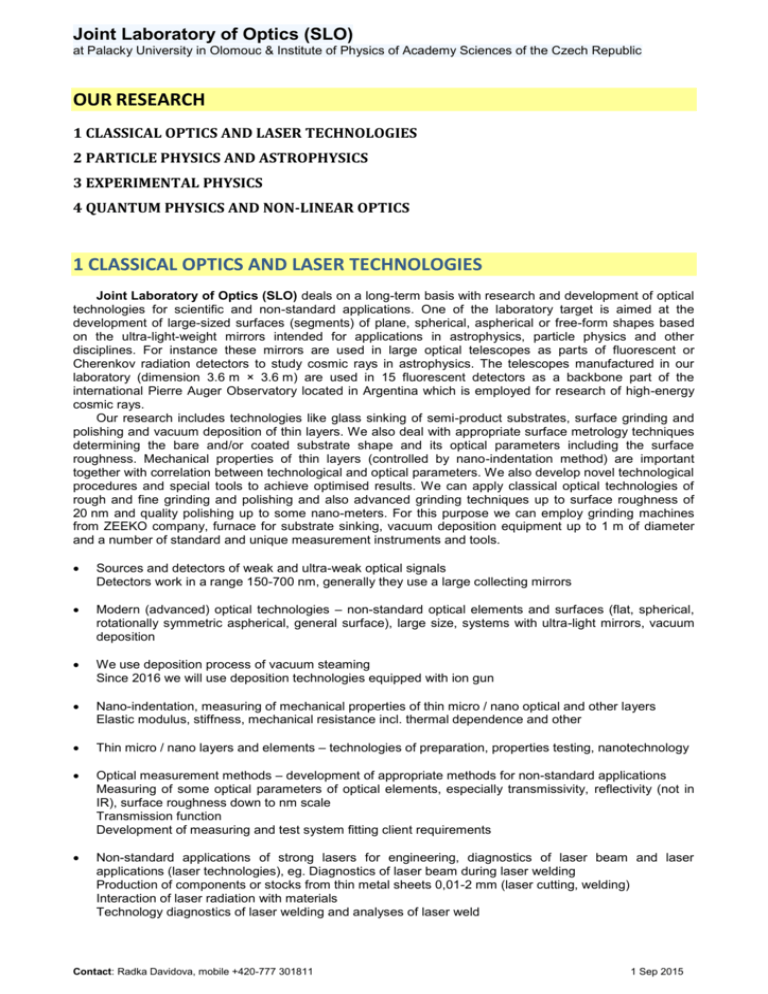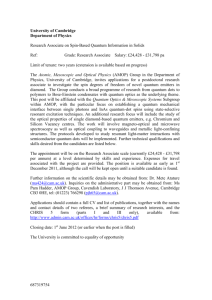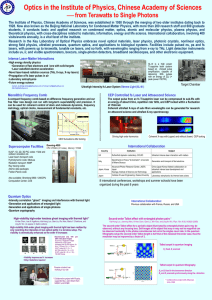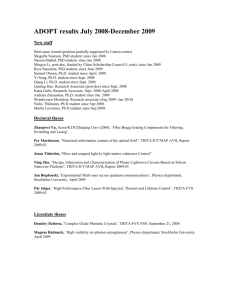1 classical optics and laser technologies
advertisement

Joint Laboratory of Optics (SLO) at Palacky University in Olomouc & Institute of Physics of Academy Sciences of the Czech Republic OUR RESEARCH 1 CLASSICAL OPTICS AND LASER TECHNOLOGIES 2 PARTICLE PHYSICS AND ASTROPHYSICS 3 EXPERIMENTAL PHYSICS 4 QUANTUM PHYSICS AND NON-LINEAR OPTICS 1 CLASSICAL OPTICS AND LASER TECHNOLOGIES Joint Laboratory of Optics (SLO) deals on a long-term basis with research and development of optical technologies for scientific and non-standard applications. One of the laboratory target is aimed at the development of large-sized surfaces (segments) of plane, spherical, aspherical or free-form shapes based on the ultra-light-weight mirrors intended for applications in astrophysics, particle physics and other disciplines. For instance these mirrors are used in large optical telescopes as parts of fluorescent or Cherenkov radiation detectors to study cosmic rays in astrophysics. The telescopes manufactured in our laboratory (dimension 3.6 m × 3.6 m) are used in 15 fluorescent detectors as a backbone part of the international Pierre Auger Observatory located in Argentina which is employed for research of high-energy cosmic rays. Our research includes technologies like glass sinking of semi-product substrates, surface grinding and polishing and vacuum deposition of thin layers. We also deal with appropriate surface metrology techniques determining the bare and/or coated substrate shape and its optical parameters including the surface roughness. Mechanical properties of thin layers (controlled by nano-indentation method) are important together with correlation between technological and optical parameters. We also develop novel technological procedures and special tools to achieve optimised results. We can apply classical optical technologies of rough and fine grinding and polishing and also advanced grinding techniques up to surface roughness of 20 nm and quality polishing up to some nano-meters. For this purpose we can employ grinding machines from ZEEKO company, furnace for substrate sinking, vacuum deposition equipment up to 1 m of diameter and a number of standard and unique measurement instruments and tools. Sources and detectors of weak and ultra-weak optical signals Detectors work in a range 150-700 nm, generally they use a large collecting mirrors Modern (advanced) optical technologies – non-standard optical elements and surfaces (flat, spherical, rotationally symmetric aspherical, general surface), large size, systems with ultra-light mirrors, vacuum deposition We use deposition process of vacuum steaming Since 2016 we will use deposition technologies equipped with ion gun Nano-indentation, measuring of mechanical properties of thin micro / nano optical and other layers Elastic modulus, stiffness, mechanical resistance incl. thermal dependence and other Thin micro / nano layers and elements – technologies of preparation, properties testing, nanotechnology Optical measurement methods – development of appropriate methods for non-standard applications Measuring of some optical parameters of optical elements, especially transmissivity, reflectivity (not in IR), surface roughness down to nm scale Transmission function Development of measuring and test system fitting client requirements Non-standard applications of strong lasers for engineering, diagnostics of laser beam and laser applications (laser technologies), eg. Diagnostics of laser beam during laser welding Production of components or stocks from thin metal sheets 0,01-2 mm (laser cutting, welding) Interaction of laser radiation with materials Technology diagnostics of laser welding and analyses of laser weld Contact: Radka Davidova, mobile +420-777 301811 1 Sep 2015 Joint Laboratory of Optics (SLO) at Palacky University in Olomouc & Institute of Physics of Academy Sciences of the Czech Republic 2 PARTICLE PHYSICS AND ASTROPHYSICS Detection of weak and ultra-weak optical signals in particle physics and astrophysics Fluorescence detectors based on an optical telescope – construction, measurements, development, maintenance Cherenkov detectors based on optical telescope – construction, measurements, development, maintenance Application Examples: - CTA Collaboration, Introducing the CTA concept, Astroparticle Physics 43 (2013) 3–18. - Celeste Collaboration, CELESTE: an atmospheric Cherenkov telescope for high energy gamma astrophysics, Nuclear Instruments and Methods in Physics Research A 490 (2002) 71–89. - Auger Collaboration, Properties and performance of the prototype instrument for the Pierre Auger Observatory, Nuclear Instruments and Methods in Physics Research A 523 (2004) 50–95. The group also participates in prestigious international projects such as CERN-ATLAS (research on the nature of matter at the LHC accelerator at CERN in Geneva) and the Pierre Auger Observatory (research on observation and analysis of high energy cosmic radiation). Modelling of detection and processes in particle physics and astrophysic We model experiments in GEANT4. 3 EXPERIMENTAL PHYSICS Building set-up for non-standard experiments based on optics, opto-electronics and fine mechanics for industry, production line, controlling of manufacturing processes, medicine etc. SW for analysis, monitoring and optimization of manufacturing processes Using All-sky cameras for permanent observation of the sky or atmosphere to control and optimize experiments in astrophysics, physics, meteorology, and other. The research group is interested in development, testing, production and servicing equipment and SW for night sky monitoring. This equipment is All Sky cameras with its own program facility that allows monitoring e.g. clouds, scattered background light level, atmospheric extinction for the entire night sky. Software allows automatic cloud detection through star astrometry, monitoring brightness of catalogue selected stars in different spectral ranges (UV/VIS), measuring of night sky radiance in visible spectrum. SW is designed for specific application and location. Described system can work autonomously without electricity and internet, and is capable to carry on in longterm measurements for assessment of parameters mentioned above. Data collection is possible per transmission over mobile network or by block data transfer by an operator. This equipment can be supplied by sensors of temperature, humidity, wind, etc. The system can be configured in aspect of used CCD chips, optics as well as used optical filters. The system can be used for educational purposes (school measurement with remote access), sky monitoring at observatories (time optimisation in observatory service) or monitoring of locations selected for future observatories. Contact: Radka Davidova, mobile +420-777 301811 1 Sep 2015 Joint Laboratory of Optics (SLO) at Palacky University in Olomouc & Institute of Physics of Academy Sciences of the Czech Republic 4 QUANTUM PHYSICS AND NON-LINEAR OPTICS Detection of weak photon fields and research of its statistic and correlation properties, e.g. pair photon fields gained in a process of spontaneous parametric down-conversion. Metrology with usage of correlated photon pairs, e.g. measurement of absolute quantum efficiency of the detectors. Modelling of dielectric and metal-dielectric photonic structures for applications in non-linear optics. Development and experimental realisation of components for quantum information processing and quantum cloning (quantum cloners, quantum gates). PRESS RELEASE /May 2015, Palacky University in Olomouc/ Scientist from Faculty of Science in Olomouc are able to ten times increase effectiveness of devices for quantum information processing in which information is transferred in a form of single photons, smallest packages of light energy. This is possible thanks to special quantum gate that is a circuit for quantum processors. Although the gate is constructed already four years, scientist discovered another key utilization now. Designed gate can transform quantum state of one photon accordingly to state of the other one. Comparing to other circuits this one is unique, because as a first one in the world it showed how to effectively tune an interaction power between two photons. “This fact opens for us new possibilities in using a gate. The gate can significantly simplify and stream-line circuits for quantum computers. It can dramatically upgrade their effectiveness” said Karel Lemr from Joint Laboratory of Optics (SLO) UP and FZÚ AV ČR, who received Siemens Award 2012 for his research. This discovery was published in prestigious American Journal Physical Review Letters (PRL). “Elementary quantum communication networks already exist yet, but very simple, with one dispatcher and one receiver, and without active communicating elements. They are commercially available for quantum cryptography that is used by banks or so. However, systems are not full-valued analogy to the classic internet yet,” said Antonín Černoch from SLO. He added: “Our gate can play an important role as an active communicating element. i.e. a kind of analogy to routers or switches. During quantum communication are necessary junctions where information are partly processed. In here information is transferred from light to solid-state system but losses and noise shall occur. It is much better if this happens only with light that is easier to work with. Quantum data elaboration and its transmission are safer and they represent significant step in IT. CONTACT Palacky University Olomouc Joint Laboratory of Optics UP and FZÚ AV ČR 17. listopadu 50a | 772 07 Olomouc | Czech Republic doc. RNDr. Ondřej HADERKA, Ph.D. Head of department T: +420 585 631 511 ondrej.haderka@upol.cz | www.upol.cz Contact: Radka Davidova, mobile +420-777 301811 Mgr. Radka DAVIDOVÁ project manager T: +420 585 634 284 | +420 777 301 811 radomira.davidova@upol.cz | www.upol.cz 1 Sep 2015







